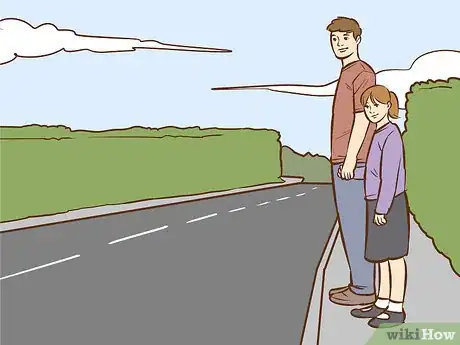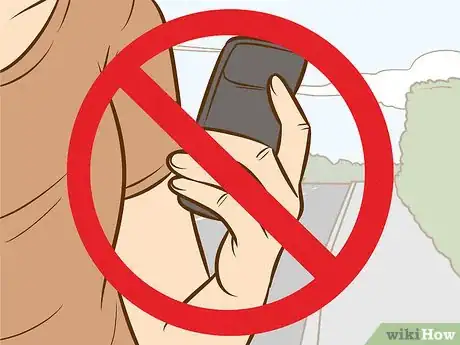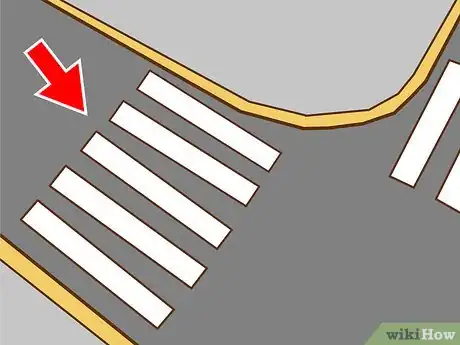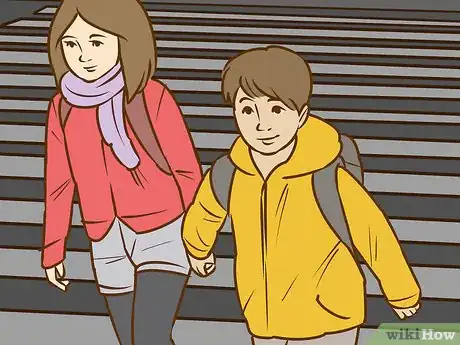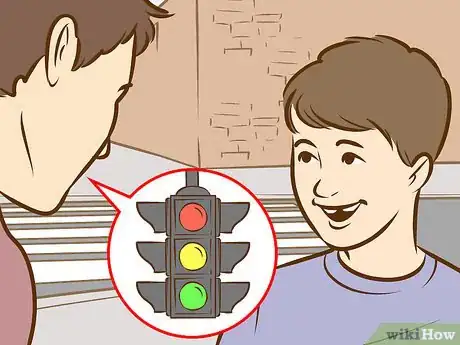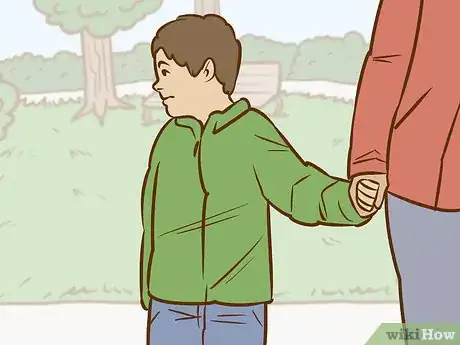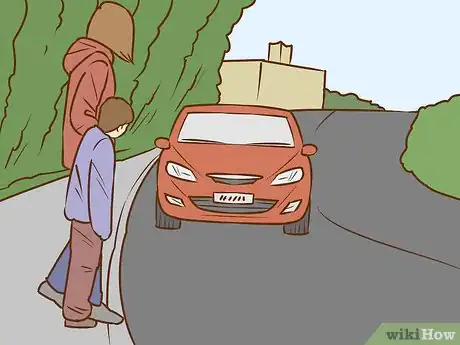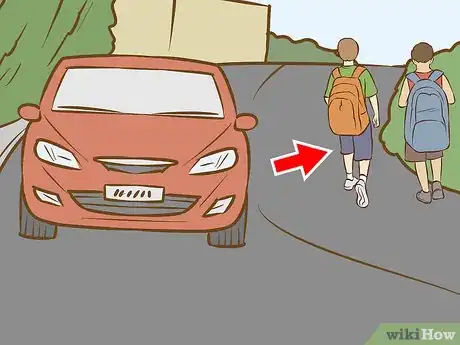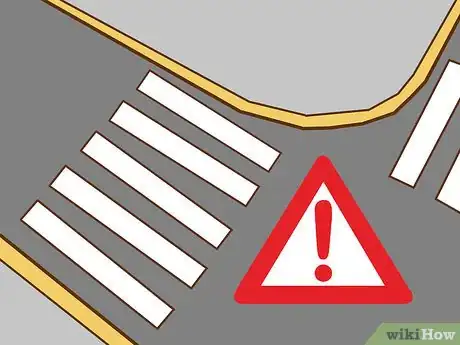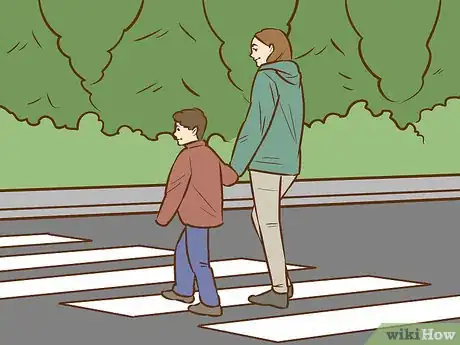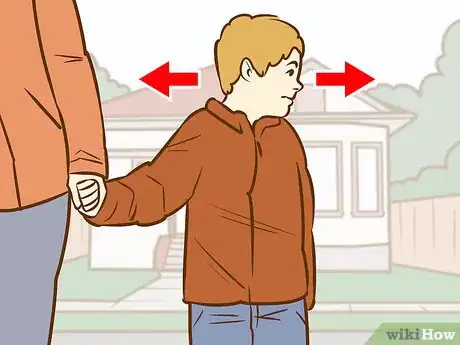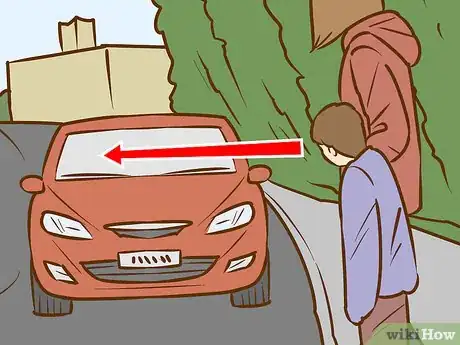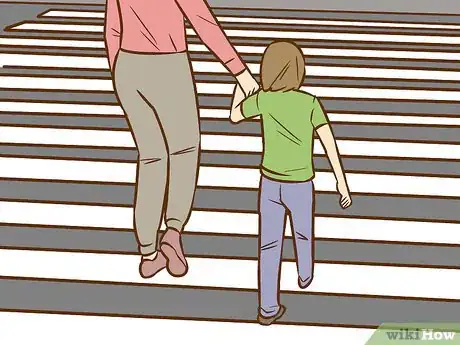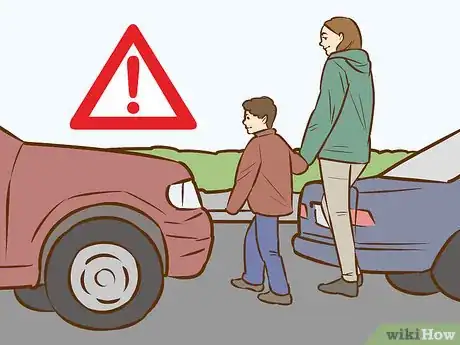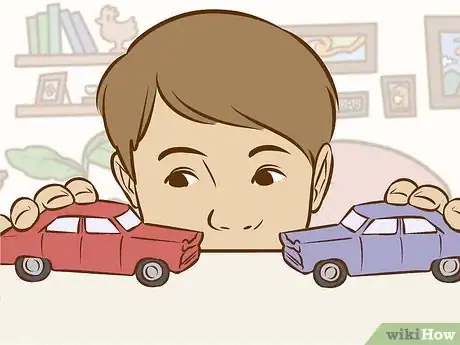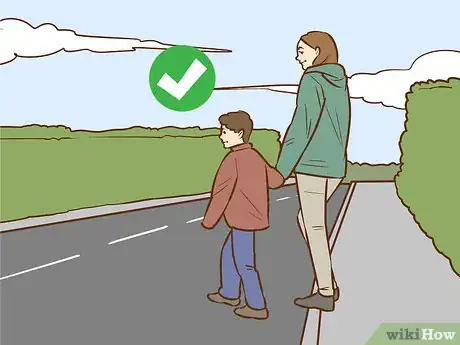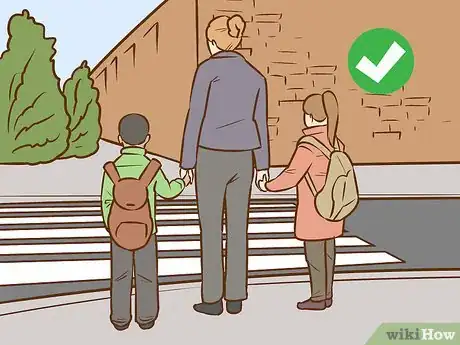This article was co-authored by Catherine Palomino, MS. Catherine Palomino is a former Childcare Center Director in New York. She received her MS in Elementary Education from CUNY Brooklyn College in 2010.
There are 7 references cited in this article, which can be found at the bottom of the page.
This article has been viewed 198,409 times.
Every parent knows that streets and street crossings pose a threat to the safety of their children. Children don’t have the ability to judge distance and speed as well as adults do. That’s why it’s all the more important to start teaching street safety while they’re young. While you’re out and about, show them the steps it takes to stay safe, such as by stopping at crosswalks and obeying traffic signals. It pays off when you have peace of mind knowing your children never forget to respect the rules of the road.
Steps
Walking Safely with a Child
-
1Accompany children under ten years old. Independence is great and all, but streets are very busy places. There are moving vehicles, signs, lights, and plenty of distractions. No matter how sure you are that your kid knows what to do, they need time to develop. Look on the bright side, though. You get to be with them until they’re old enough to feel embarrassed at being seen in public with their parent.[1]
- All children learn and develop differently. After your child reaches their tenth birthday, it’s up to you to decide if they’re ready to do this on their own. If not, it’s all right to continue to teach them.
- Teach young children to hold onto your hand while you're walking on the street. Don't let them run out ahead of you.
-
2Put away phones and other distractions. That means you too, mom and dad. Set a good example by storing your devices. Wrestle your teenager to get their phone away from them if that’s what it takes. Video games and toys also pose a significant distraction to younger children. By far the forgotten threat is in headphones, which take away a sense that’s very important to street safety.[2]
- No one should wear headphones when they’re around cars. You wouldn’t wear them while you’re driving, and walking is no different.
Advertisement -
3Walk near low-speed roads without much traffic. The best locations for learning street safety are the least intimidating ones. Slow and low-speed roads pose the least threat. These kinds of roads are often found in community side roads away from town centers. You know your area best, so you can direct your child to safer routes. Also, adjust your route when walking with your child so you can teach them in a calmer, safer environment.
- Take the time to plan out your walks. Residential streets or crossings with lots of pedestrians can be good learning spots for children.
-
4Wear colorful clothing in the evening. No doubt you’d rather not have your child outside at night. You’re right to be afraid, since you know that the dark makes pedestrians harder to spot. Still, it’s a good idea to teach your child how to manage this situation now. Tell them about it and if you’re out in the evening, have everyone wear bright clothing. Put aside the black and blue. Break out that lime green t-shirt at the bottom of your drawer.
- Following proper street safety rules, such as obeying traffic signals and utilizing crosswalks, is even more essential at night.
- Have your children wear clothing and/or backpacks that have light-reflective strips, which will make them more visible. You can find reflective safety strips sold separately so that you can apply them to your children's clothes and personal items.
-
5Explain street signs frequently. It’s easy to spot a sign and ask them, “What does that sign mean?” The problem is that many children, especially young children, need to be reminded of this constantly. It’s not their fault though, so stay patient and informative. As you walk with them, start explaining what each street sign means. On subsequent walks, ask them what the signs mean. When they get it wrong, gently explain the correct answer.
- Be sure to point out every sign you see so that the child learns the difference between the different signs. For example, you may see stop signs, cross walk signs, street signs, neighborhood watch signs, etc.
- At first kids will repeat back the explanations you give them. When they can give you answers in their own words, you’ll know they’ve memorized the lesson.
-
6Show them what traffic signals mean. You never have to think of what a signal means, so you take them for granted. Children have no concept of the meanings adults assign to colors and symbols. Show them those traffic lights and signs. Also, explain the symbols on crosswalk lights. A blinking sign for “don’t start walking” is different than a solid sign for “don’t walk.”
- An easy way to do this is by walking with them through a crosswalk that has both traffic lights and crosswalk lights nearby. Once they know enough, you can have them decide when it’s safe to walk. Choose a time when traffic is light.
- It's a good idea to use flashcards to help teach younger children what traffic signals mean. This way they can learn in a safe setting.
- As you drive or walk with your child, point out new signals that you come across so that they child will become familiar with them.
-
7Teach children to stop at all roads. This is a primary concern for most parents. A ball rolls into the street or a child sees something that distracts them, such as a friend on the other side, so they run. From a young age, instruct children that “roads are not for playing.” They’ll learn to wait until the coast is clear and get across the street in a timely manner.
- Even if you catch them making a mistake, be gentle. Do your best to stay calm and explain the danger.
-
8Have children walk facing traffic when there’s no sidewalk. Sometimes street conditions aren’t ideal. Although these situations should be avoided as much as possible, they’re still worth learning. Too many people don’t know that they should walk so that traffic is coming towards them. This way, your child will be able to see and react to dangerous drivers.
- Teach children to “keep their eyes on cars.” They can’t do this when they’re not facing traffic.
-
9Walk as far to the left as possible when there’s no sidewalk. When there’s no sidewalk, everyone must get as far away from the road as possible. You’ve probably encountered those moments where you’re nervous because you don’t feel separated enough from these large vehicles speeding by. Children are harder to see than you, so getting off the road is a lifesaver. You never know when a car will drift over the line.[3]
- Even when you’re on a sidewalk, placing your child to the left of you can protect them from an unexpected accident.
-
10Teach awareness near driveways and other blind spots. Driveways tend to be particularly dangerous spots for younger kids. You’ve probably been in situations where you’ve backed out and been unable to see the sidewalk or another car. This can also happen around alleys and street corners. Remind children that drivers can’t see very well and might forget to slow down. Have them stop and look before continuing on your walk.[4]
- Teach them how to respond in these situations, such as by jumping back or freezing in place.
Crossing Streets
-
1Have children always cross at a crosswalk. Crosswalks and corners exist for a reason. Many adults put themselves at greater risk by scurrying across the street whenever they want. That’s a very dangerous lesson to show a child, so guide them to the crossing zones even if you have to go out of your way a little. Getting to rule the crosswalk lines is fun and makes you more visible to motorists.[5]
- Model good behavior by always using crosswalks yourself. If you witness someone else crossing improperly, remind your child that this is incorrect and dangerous.
- If you have younger children, hold their hand while you cross. Instruct older children to cross when you do.
- Crosswalk lights can be tricky for younger children. When they see the the blinking hand pop up, they may freeze in the middle of the street. That’s why you’re there to guide them.
- Play games with them such as “I Spy” or “Guess the meaning of the sign.” For example, you can ask, “What does this sign mean? Should we stop or walk?” Praise them for getting it right.
-
2Remind your child to stop and look both ways before crossing. “Look left, right, left.” Your parents probably hammered a similar song into your head when you were young. Before you step into the street, have them look for any danger. Continue looking and listening even after you begin crossing. Cars that appear distant may reach you faster than expected. Drivers make mistakes too, so it’s up to you and your child to protect yourself by waiting until the coast is clear before crossing.
- Try asking the child what they should do during different situations. At a crosswalk, expect them to answer with something like “I stop and look both ways.” Eventually, they’ll be able to say this back in their own words, proving that they understand.
- Listening while crossing is almost as important as looking. Newer cars and hybrids can be very quiet.
-
3Have children make eye contact with drivers while crossing. A road is an ever-changing place. Even a situation that appears safe can quickly develop into an accident. Have your child search out the eyes of drivers they approach. Drivers you look in the eye are more likely to stop. Your child will soon recognize drivers who aren’t paying attention.[6]
- Some vehicles, such as those with tinted windows, make eye contact impossible, but it’s always worth trying.
-
4Hold a young child’s hand as they cross. Anyone who has been in the presence of a young child knows how much they enjoy running ahead of you. Many children also lack the attention span required to get across the street promptly. At least until age six, lead them by the hand. Grab your teenager too when they’re too distracted to be street safe.[7]
- This is a golden opportunity to let them decide when it’s safe to cross. Ask them “is it safe?” and don’t move until they say yes. This can also be helpful for developmentally disabled children.
-
5Explain the danger of crossing between parked cars. Besides driveways, parked cars are a leading cause of accidents. This sounds weird, but think about it. It’s very difficult to see someone when they come out from between two cars. Even adults make this mistake, but children are much smaller and harder to see. It’s very important your child knows to go to a street crossing![8]
- Never try to scare children with street dangers. Instead, calmly explain them so they learn the lessons rather than get distracted by your tone.
Being an Engaging Teacher
-
1Keep your instructions short and clear. Avoid giving long lectures on street safety. As an adult, you probably don’t want to give them either. Children aren’t going to remember all of what you say anyway. “Red means stop” or “look left, right left” are far easier to understand than a lengthy explanation on traffic safety. Spare yourself the breath, since you’ll need to repeat these instructions many times for younger children.
- Instead of explaining, spend more time asking the child what to do next or quizzing them on street signs.
-
2Model safety behavior with toy cars for younger kids. It doesn’t hurt to incorporate a little visual learning. Try using toy cars to set up safety scenarios, such as with driveways or crossings. Those play mats that look like big road maps come in handy for this, providing an opportunity to teach kids without taking them outside. Your child will probably appreciate trading a little educational time for some new toy cars, too.[9]
-
3Make learning fun with games. Reiterating safety lessons while walking is a very useful teaching method, but games make important points more memorable. One way to do this is with the I Spy game. Say something like, “I spy a red sign that means stop” and let them answer. They might have so much fun they don’t realize you’re giving them an educational lesson![10]
- While indoors, you could print out traffic signs and let kids interpret them. You might also dress up as traffic signs or colors for a sight no kid would forget!
- You could also use toy signs and signals and have your kids play out different traffic scenarios. Ask them what the safest decision in each scenario would be.
- Inventing safety songs or painting scenarios such as a “safe crossing at the street corner” might also be fun.
-
4Let the child decide when to walk. Give children a little executive power. When you come up to a crossing or other teaching point, stop in place. Ask them if it’s safe to walk. You can test them by letting them squeeze your hand or signal that it’s time to cross. They’ll enjoy being able to make the decision.
- If they don’t know all the safety procedures yet, you can also have them recite the steps. For example, sing, “Stop, look, listen, stay safe!”
-
5Teach them together with friends or siblings. It’s more fun to learn together. That’s what makes classrooms great places, but you can do this with another child. Children take cues from others, so they’ll feel encouraged to join in with the learning. Go ahead and coordinate with other parents or teach your own children together at the same time.
- Sometimes giggling can be a distraction. Do your best to get everyone to focus. Be persistent before you continue walking or teaching.
Expert Q&A
-
QuestionHow do you teach street safety skills to developmentally disabled adults?
 Catherine Palomino, MSCatherine Palomino is a former Childcare Center Director in New York. She received her MS in Elementary Education from CUNY Brooklyn College in 2010.
Catherine Palomino, MSCatherine Palomino is a former Childcare Center Director in New York. She received her MS in Elementary Education from CUNY Brooklyn College in 2010.
Master's Degree, Elementary Education, CUNY Brooklyn College It's great that you want to teach a developmentally disabled adult street safety! First, create realistic goals alongside either the student or their guardian. Then create an individualized lesson plan that is geared toward their abilities. You could even adapt an existing training plan to meet your student's needs. You may want to modify and use the tips, tricks, and games in the article above. Regularly check the process of your student by talking to them to find out how much they remember.
It's great that you want to teach a developmentally disabled adult street safety! First, create realistic goals alongside either the student or their guardian. Then create an individualized lesson plan that is geared toward their abilities. You could even adapt an existing training plan to meet your student's needs. You may want to modify and use the tips, tricks, and games in the article above. Regularly check the process of your student by talking to them to find out how much they remember. -
QuestionHow do I give simple instructions when teaching children?
 Community AnswerUse short simple words and phrases. The best way to teach children is to lead by example and tell them, "look left, right, left before crossing," while doing the actions.
Community AnswerUse short simple words and phrases. The best way to teach children is to lead by example and tell them, "look left, right, left before crossing," while doing the actions. -
QuestionWhat do the triangles mean on the road surface?
 Dino1Community AnswerThe triangles mean you must yield for oncoming traffic.
Dino1Community AnswerThe triangles mean you must yield for oncoming traffic.
Warnings
- Avoid being a messenger of doom. Yes, roads are dangerous, but they are a manageable danger. Teaching your children fear will do more harm than good.⧼thumbs_response⧽
- Accidents on the road are very common, especially during the peak traffic hours.⧼thumbs_response⧽
References
- ↑ https://www.safekids.org/walkingsafelytips
- ↑ https://www.safekids.org/walkingsafelytips
- ↑ http://www.chp.edu/injury-prevention/safety/street/safety
- ↑ http://www.chp.edu/injury-prevention/safety/street/safety
- ↑ http://www.huffingtonpost.com/mary-l-pulido-phd/teaching-your-child-to-cross-the-street-can-save-their-life_b_7215698.html
- ↑ https://www.psychologicalscience.org/news/motr/safe-crossings-the-power-of-eye-contact.html
- ↑ http://www.friendshipcircle.org/blog/2012/07/25/traffic-safety-for-children-with-special-needs/
- ↑ http://www.chp.edu/injury-prevention/safety/street/safety
- ↑ http://roadsafetyweek.org/schools-colleges/2-uncategorised/69-road-safety-lesson-plans%23twofive
